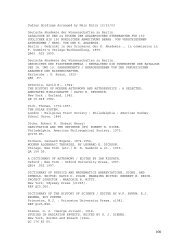K-6 Activities - Dudley Observatory
K-6 Activities - Dudley Observatory
K-6 Activities - Dudley Observatory
You also want an ePaper? Increase the reach of your titles
YUMPU automatically turns print PDFs into web optimized ePapers that Google loves.
Materials<br />
• STARLAB Portable Planetarium<br />
• Projector<br />
• Starfield Cylinder<br />
Objective<br />
K–6 <strong>Activities</strong> • B–72 •<br />
Apparent Motion, Activity 6-3<br />
The student should be able to demonstrate an understanding of the reasons for the<br />
apparent motion of the stars.<br />
Procedure<br />
Demonstrate these concepts as you explain this in STARLAB.<br />
The earth has two principal motions. Rotation is the turning of the earth on its axis.<br />
Revolution is the motion of the earth in its orbit around the sun. (Care should be taken<br />
not to confuse these terms when working with children). The earth rotates on its axis<br />
once in 24 hours (rounded off). When viewed from above the North Pole, the earth<br />
turns in a counterclockwise direction. It might be less confusing to children if the earth<br />
is thought of as turning from west to east. The sun appears to rise in the east. We<br />
know that the earth is moving and the sun is “standing still.” Therefore, we must be<br />
moving toward the sun at sunrise or toward the east. It is important to see that sun<br />
time varies from east to west because of the earth’s rotation. For example, sunrise<br />
occurs in New York long before it does in California.<br />
When the earth is observed from above the North Pole, it appears as a circle. All<br />
circles contain 360°; therefore it is 360° around the earth. We know that the earth<br />
turns once in 24 hours. By dividing the distance around the earth (360°) by the time<br />
it takes for the earth to rotate once on its axis (24 hours) we find that the earth turns<br />
15° per hour. It is extremely important for children to realize that the apparent night<br />
motion of the stars is due to the earth’s rotation, and not movement of the stars! Think<br />
of the stars as being stationary in space. What will a star on the eastern horizon appear<br />
to do as the earth turns toward the east? Obviously it will appear to rise. Following<br />
the same logic, it is apparent that the North Star will not appear to move since it<br />
is over the axis of the earth. The stars which are near the North Star will appear to<br />
circle the earth. The stars which are near the North Star will appear to circle it since<br />
they are seen too far above the horizon to rise and set.<br />
The movement of the earth around the sun is called revolution. The earth revolves<br />
about the sun in approximately 365 and 1/4 days or one calendar year. While the<br />
earth is revolving around the sun, its axis points toward the North Star (Polaris).<br />
Since the axis angle never changes, the angle between the earth’s axis and the sun<br />
is constantly changing; giving us our seasons and causing changes in the stars which<br />
are visible.





